Newly identified patterns of Pax2 expression in the developing mouse forebrain
- PMID: 18700968
- PMCID: PMC2531185
- DOI: 10.1186/1471-213X-8-79
Newly identified patterns of Pax2 expression in the developing mouse forebrain
Abstract
Background: The availability of specific markers expressed in different regions of the developing nervous system provides a useful tool for the study of mouse mutants. One such marker, the transcription factor Pax2, is expressed at the midbrain-hindbrain boundary and in the cerebellum, spinal cord, retina, optic stalk, and optic chiasm. We recently described a group of diencephalic cells that express Pax2 as early as embryonic day (E) 10.5, and become part of the eminentia thalami by E11.5. The discovery of this previously undescribed cell population prompted us to examine Pax2 protein expression in the developing mouse forebrain in more detail.
Results: We determined the expression pattern of Pax2 in the forebrain of wild type mouse embryos between E10.5 and postnatal day (P) 15. Pax2 expression was detected in the septum of the basal forebrain, hypothalamus, eminentia thalami and in the subfornical organ. To evaluate Pax2 as a marker for septal cells, we examined Pax2 expression in Pax6Sey/Sey mutants, which have an enlarged septum. We found that Pax2 clearly marks a population of septal cells equivalent to that seen in wild types, indicating its utility as a marker of septal identity. These cells did not express the GABAergic marker calbindin nor the cholinergic marker choline acetyltransferase and were not detectable after P15.
Conclusion: Pax2 is expressed in populations of cells within the developing septum, hypothalamus, and eminentia thalami. It seems especially useful as a marker of the telencephalic septum, because of its early, strong and characteristic expression in this structure. Further, its expression is maintained in the enlarged septum of Pax6Sey/Sey mutants.
Figures
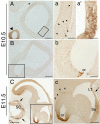
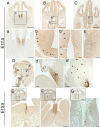
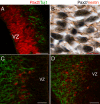
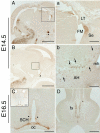
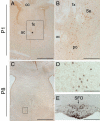
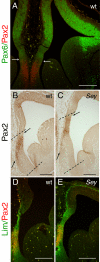

Similar articles
-
Eye-specific expression of an ancestral jellyfish PaxB gene interferes with Pax6 function despite its conserved Pax6/Pax2 characteristics.Int J Dev Biol. 2009;53(4):469-82. doi: 10.1387/ijdb.082793jr. Int J Dev Biol. 2009. PMID: 19378250
-
Overexpression of Pax6 results in microphthalmia, retinal dysplasia and defective retinal ganglion cell axon guidance.BMC Dev Biol. 2008 May 28;8:59. doi: 10.1186/1471-213X-8-59. BMC Dev Biol. 2008. PMID: 18507827 Free PMC article.
-
Midline signalling is required for Pax gene regulation and patterning of the eyes.Development. 1995 Oct;121(10):3267-78. doi: 10.1242/dev.121.10.3267. Development. 1995. PMID: 7588061
-
[PAX gene function during kidney tumorigenesis: a comparative approach].Bull Cancer. 2006 Sep;93(9):875-82. Bull Cancer. 2006. PMID: 16980230 Review. French.
-
Cavitary anomalies of the optic disc: neurologic significance.Curr Neurol Neurosci Rep. 2008 Sep;8(5):409-13. doi: 10.1007/s11910-008-0063-5. Curr Neurol Neurosci Rep. 2008. PMID: 18713577 Review.
Cited by
-
Expression of Developmentally Important Axon Guidance Cues in the Adult Optic Chiasm.Invest Ophthalmol Vis Sci. 2019 Nov 1;60(14):4727-4739. doi: 10.1167/iovs.19-26732. Invest Ophthalmol Vis Sci. 2019. PMID: 31731293 Free PMC article.
-
Complex haploinsufficiency in pluripotent cells yields somatic cells with DNA methylation abnormalities and pluripotency induction defects.Stem Cell Reports. 2023 Nov 14;18(11):2174-2189. doi: 10.1016/j.stemcr.2023.09.009. Epub 2023 Oct 12. Stem Cell Reports. 2023. PMID: 37832543 Free PMC article.
-
The Role of PAX2 in Neurodevelopment and Disease.Neuropsychiatr Dis Treat. 2021 Dec 7;17:3559-3567. doi: 10.2147/NDT.S332747. eCollection 2021. Neuropsychiatr Dis Treat. 2021. PMID: 34908837 Free PMC article. Review.
-
The molecular and cellular signatures of the mouse eminentia thalami support its role as a signalling centre in the developing forebrain.Brain Struct Funct. 2016 Sep;221(7):3709-27. doi: 10.1007/s00429-015-1127-3. Epub 2015 Oct 12. Brain Struct Funct. 2016. PMID: 26459142 Free PMC article.
-
Lhx2 regulates the development of the forebrain hem system.Cereb Cortex. 2014 May;24(5):1361-72. doi: 10.1093/cercor/bhs421. Epub 2013 Jan 10. Cereb Cortex. 2014. PMID: 23307637 Free PMC article.
References
-
- Dressler GR, Deutsch U, Chowdhury K, Nornes HO, Gruss P. Pax2, a new murine paired-box-containing gene and its expression in the developing excretory system. Development. 1990;109:787–795. - PubMed
-
- Mansouri A, Hallonet M, Gruss P. Pax genes and their roles in cell differentiation and development. Curr Opin Cell Biol. 1996;8:851–857. - PubMed
-
- Stuart ET, Kioussi C, Gruss P. Mammalian Pax genes. Annu Rev Genet. 1994;28:219–236. - PubMed
-
- Nornes HO, Dressler GR, Knapik EW, Deutsch U, Gruss P. Spatially and temporally restricted expression of Pax2 during murine neurogenesis. Development. 1990;109:797–809. - PubMed
Publication types
MeSH terms
Substances
Grants and funding
LinkOut - more resources
Full Text Sources
Molecular Biology Databases

